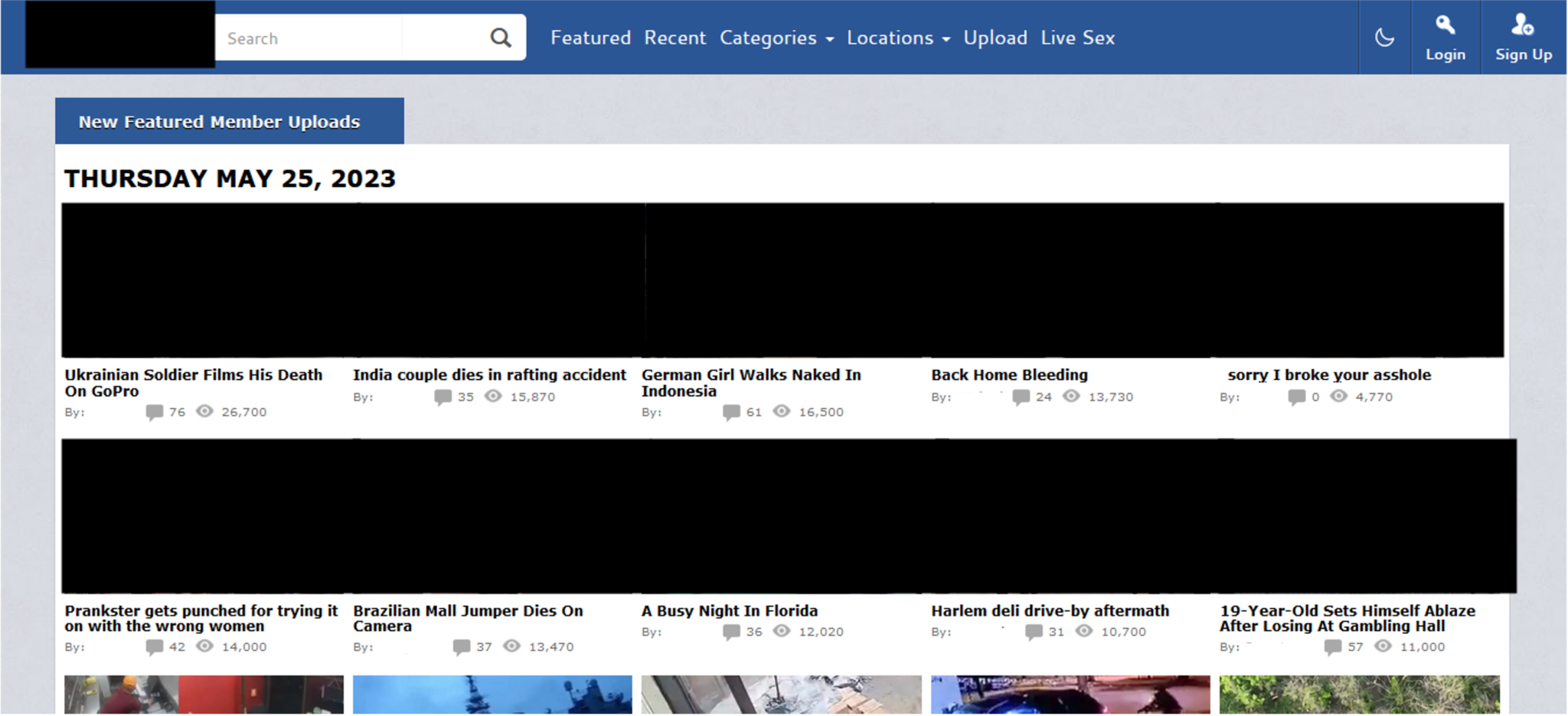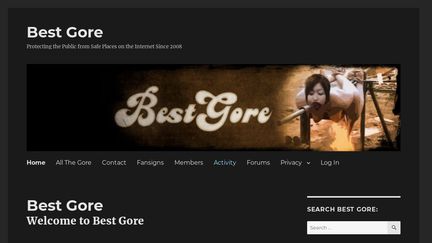Unveiling The Dark Corners: A Look Into Gore Websites
The internet is a vast and intricate landscape, offering an unparalleled wealth of information, entertainment, and connection. However, within its boundless expanse lie certain corners that are far from pleasant, often deliberately disturbing, and certainly not for the faint of heart. These are the so-called "gore websites," platforms dedicated to displaying graphic, violent, and often deeply unsettling content. They exist on the fringes of mainstream internet culture, attracting a niche audience drawn by morbid curiosity, a desire for unfiltered reality, or simply the pursuit of shock.
This article aims to shed light on what these websites are, the kind of content they host, their history, and the complex reasons behind their existence. It's important to approach this topic with caution, as the nature of these sites is inherently graphic and disturbing. Viewer discretion, even when reading about them, is strongly advised.
What Exactly Are "Gore Websites"?
At their core, gore websites are online platforms that host and display extremely violent, graphic, and often real-life content. Unlike mainstream news outlets that censor or contextualize disturbing imagery, these sites often present material in its raw, unfiltered form. Their primary purpose can vary, from attempting to provide an "unfiltered reality" to simply existing as "shock sites" designed to provoke strong emotional reactions.
As one prominent example, Livegore describes itself as "a reality news website which reports on real life events which are of interest to the public." It explicitly states, "Gore isn't funny, to tell the truth, reality since 2020." This perspective suggests an aim to expose the harsh realities of the world, without the sanitization typically found elsewhere. Similarly, Goregrish asserts, "We show you reality since 2022," implying a commitment to raw, unvarnished content.
A Glimpse into Their Content
The content found on gore websites is consistently graphic and can encompass a wide range of disturbing real-life events. Based on the explicit descriptions from various sites, common categories and types of videos and images include:
- Executions: Videos and photos depicting the act of execution, often in brutal detail. Sites like "Deep Gore Tube" are known for posting "the most brutal execution videos in the world."
- Beheadings and Dismemberment: Graphic footage of individuals being beheaded or dismembered, frequently attributed to criminal gangs or terror groups. Xgore.net, for instance, features "latest murder photos and videos" including "beheading, dismemberment, execution of victims by gangs."
- Torture: Visuals of individuals undergoing torture. Livegore specifically lists "torture" among its browseable categories.
- True Crime: A significant portion of content revolves around real-life criminal acts. Livegore "includes videos relating to true crime that have been taken from across the world." This can range from footage of war and criminal activities to terror attacks and clandestine operations. An example cited is a captive, said to oversee CJNG operations, reportedly confessing to fuel theft.
- Accidents and Fatalities: Unfiltered footage of fatal accidents, natural disasters, and other events resulting in death.
Sites like Goresee function as a "hub for gore videos," allowing users to search for content by video names, descriptions, or channel names, indicating a vast, searchable archive of disturbing material.
The History and Evolution of Shock and Gore Sites
The concept of websites designed to shock or disturb viewers is not new. It dates back to the early days of the internet, evolving from simple "shock sites" to more specialized "gore sites."
A "shock site" is broadly defined as "a website that is intended to be offensive or disturbing to its viewers, though it can also contain elements of humor or evoke (in some viewers) sexual arousal." Early examples, while not always strictly gore, paved the way for more explicit content. For instance, Goatse.cx, which emerged in the early 2000s, became infamous for an image of a man spreading his anus open to an unbelievable degree for the camera. While not violent, it was profoundly disturbing and served as a benchmark for internet shock culture.
The lineage of dedicated gore sites can be traced through several iterations:
- Ogrish.com: This site was one of the earliest and most notorious gore platforms. It gained significant attention for its raw, uncensored content.
- Uncoverreality.com: Believed to be an offshoot of Ogrish.com, this site continued the tradition of hosting graphic material.
- Goregrish.com: Established in June 2008 under the name pwnographic.net, it changed its name and domain to goregrish.com in 2010. It is believed to be an offshoot of the now-defunct Uncoverreality.com, with many former members migrating between these platforms. Ogrish.com itself later transformed into Liveleak.com, which was a well-known platform for uncensored news and user-generated content, before eventually redirecting to ItemFix. This demonstrates a continuous evolution and rebranding within this niche online space.
The Community and Access Restrictions
Given the extremely graphic nature of their content, gore websites typically implement strict access restrictions and often foster unique community dynamics.
A common and crucial restriction is age verification. Livegore, for example, explicitly states, "Due to the graphic nature of materials found on Livegore, access is restricted to adults only (18+). Please leave this website if you are under that age!" This is a standard practice, though the effectiveness of such self-reported age gates is often debated.
Beyond age, some sites cultivate a more insular community. Goregrish hints at this with phrases like "Here is where you go when you can't play well with others" and "You will need to earn your way out." It also mentions that "members in TT will only be allowed to see this area when they come to the site, and all your posts here will be go into moderation before they are approved." This suggests a tiered access system, possibly involving a forum or specific sections reserved for active or trusted members, with content subject to moderation before public display within the community. This creates a sense of exclusivity and a controlled environment for sharing and discussing graphic material among like-minded individuals.
Regardless of the platform, strong viewer discretion warnings are universally present. "The videos in this section are graphic, so viewer discretion is strongly advised," is a common refrain, underscoring the potentially traumatic impact of the content.
Why Do These Sites Exist?
The existence of gore websites raises significant questions about human psychology, the nature of information dissemination, and the boundaries of online content. Several factors contribute to their continued presence:
- Unfiltered Reality: As Livegore and Goregrish claim, some users seek an "unfiltered reality of life and death." They believe these sites offer a raw, unvarnished look at the world that mainstream media often shies away from. For them, it's about seeing the "truth," no matter how brutal.
- Morbid Curiosity: A fundamental aspect of human nature is curiosity, even about the macabre. For some, the allure of seeing what is typically hidden or forbidden is a powerful draw.
- Shock Value: For others, the primary appeal lies in the shock itself. These sites are designed to provoke strong reactions, and for a certain segment of the population, this provocation is a form of entertainment or a way to test their own emotional limits.
- Documentation of Events: In some cases, these sites inadvertently serve as archives for documenting real-world events, particularly true crime, war, and terror incidents, that might not be widely circulated in their raw form elsewhere.
- Niche Community: As seen with Goregrish, these sites can foster communities for individuals who share an interest in extreme content, providing a space where they can discuss and share without judgment.
The Ethical and Psychological Impact
While gore websites cater to specific interests, their ethical implications and psychological impact are profound and overwhelmingly negative. Exposure to such graphic content can lead to:
- Psychological Distress: Viewers may experience anxiety, fear, nightmares, or symptoms akin to post-traumatic stress disorder (PTSD), especially if they are not accustomed to such imagery.
- Desensitization: Repeated exposure can lead to desensitization to violence, potentially dulling empathy and making real-world suffering seem less impactful.
- Glorification of Violence: Although many sites claim to show "reality," the context-free presentation of extreme violence can, for some, inadvertently contribute to its normalization or even glorification.
- Ethical Concerns: The display of real-life suffering, often without the consent of victims or their families, raises serious ethical questions about privacy, dignity, and exploitation.
It's for these reasons that repeated warnings about viewer discretion are paramount. The content is not "funny" and is explicitly designed to be disturbing, making it unsuitable for most audiences, particularly minors.
Conclusion
Gore websites represent a dark and challenging facet of the internet. They are platforms dedicated to the unfiltered display of extreme violence, death, and human suffering, ranging from true crime videos to explicit executions and torture. Tracing their lineage through sites like Ogrish.com, Uncoverreality.com, and Goregrish.com, they have evolved from general "shock sites" to specialized hubs for graphic content. While some purport to offer an "unfiltered reality," their existence is largely driven by morbid curiosity, the pursuit of shock, and the formation of niche communities. Access is typically restricted to adults, and strong warnings are issued due to the severe psychological impact of viewing such material. Ultimately, these sites serve as a stark reminder of the internet's duality – a tool for connection and information, but also a repository for humanity's most disturbing realities, requiring extreme caution and awareness from anyone who might encounter them.

Gore and violent extremism: How extremist groups exploit ‘gore’ sites

Mehdiriko Shockgorecom

BEST GORE WEBSITES Tier List Maker - TierLists.com